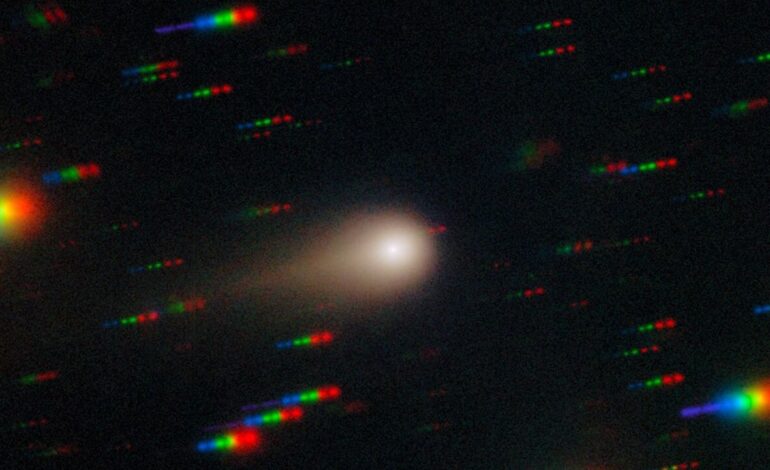Comet 3I/ATLAS Transformed by Billions of Years of Cosmic Radiation

Observations from the James Webb Space Telescope (JWST) have revealed that comet 3I/ATLAS has been profoundly altered by billions of years of cosmic radiation. The research indicates that this interstellar comet has absorbed immense amounts of galactic cosmic rays during its extensive journey through the Milky Way, resulting in a deeply irradiated crust that differs significantly from the material of its original solar system.
The study, which was posted on the preprint server arXiv on October 31, 2023, suggests that comet 3I/ATLAS has developed high levels of carbon dioxide (CO2) due to the effects of space radiation over its estimated lifespan of approximately 7 billion years. Researchers utilized JWST observations alongside computer simulations to reach these conclusions. These findings remain unverified by peer review but present a potential shift in how interstellar objects are studied.
Cosmic Rays Alter Comet’s Composition
Galactic cosmic rays, composed of high-energy particles originating outside our solar system, interact with carbon monoxide (CO) present in space, converting it into carbon dioxide (CO2). Within our solar system, the heliosphere, created by solar radiation, offers protection against much of this cosmic radiation. In contrast, comet 3I/ATLAS has spent the majority of its existence in the unshielded expanse of interstellar space.
The research team concluded that cosmic rays had significantly modified the physical state of the comet’s ice, extending to depths of about 15 to 20 meters (50 to 65 feet). Study lead author Romain Maggiolo, a research scientist at the Royal Belgian Institute for Space Aeronomy, emphasized the long-term impact of this radiation, noting, “It’s very slow, but over billions of years, it’s a very strong effect.”
The implications of these findings suggest that rather than being composed of pristine material representative of its birthplace, comet 3I/ATLAS is now largely a product of its interstellar environment.
Tracking the Journey of 3I/ATLAS
Currently, comet 3I/ATLAS is on a trajectory around the sun and reached perihelion, its closest point to the sun, on October 29, 2023. As comets approach stars, they heat up, causing surface ice to sublimate into gas. The recent research suggests that any gases released from the comet prior to perihelion originated solely from its irradiated outer shell.
Post-perihelion, it is possible that solar erosion could expose more pristine materials from the comet’s core. Maggiolo highlighted the importance of comparing observations made before and after perihelion to investigate the comet’s initial composition. “Maybe by looking at these differences, we can have some indication about its initial composition,” he stated.
Since its discovery in July 2023, astronomers have employed various telescopes to study comet 3I/ATLAS, revealing that it is traveling through our solar system at speeds exceeding 130,000 mph (approximately 210,000 km/h) along an unusually flat and straight path. Some studies suggest that this comet could be among the oldest ever observed, potentially around 3 billion years older than our own 4.6 billion-year-old solar system.
This latest research builds on earlier findings that indicated an enrichment of CO2 in comet 3I/ATLAS, based on JWST’s initial images and observations from NASA’s SPHEREx orbiter in August 2023. The research team adapted models from their previous studies on domestic comets, specifically comet 67P, to analyze the effects of cosmic ray exposure on 3I/ATLAS.
The simulations conducted indicate that a billion years of cosmic irradiation is sufficient for the development of the comet’s irradiated crust. While the laboratory experiments used to simulate these effects may not fully represent interstellar conditions, they provide a robust indicator of the transformations comets undergo throughout their lengthy journeys.
Maggiolo remarked on the significance of the findings, stating that while comet 3I/ATLAS has changed considerably over time, it continues to offer valuable insights into the nature of interstellar objects. “We have to be careful and take into account aging processes, so it’s more work for scientists, but [3I/ATLAS] remains very interesting,” he concluded.






